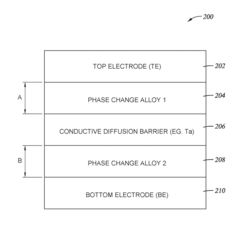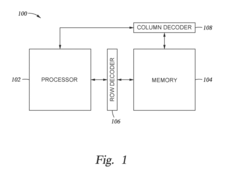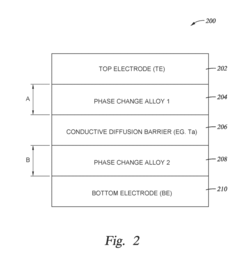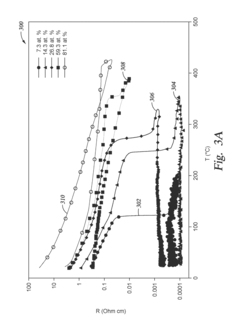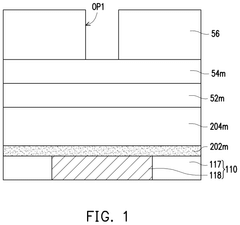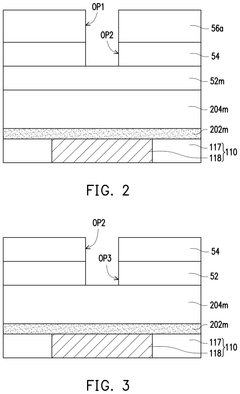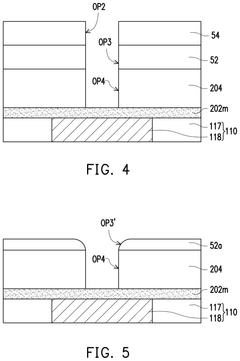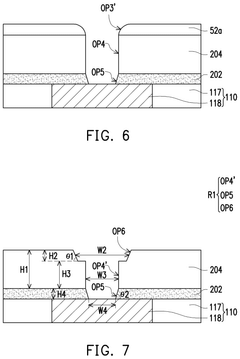Cloud-Scale Deployment Considerations For PCM Accelerators
AUG 29, 20259 MIN READ
Generate Your Research Report Instantly with AI Agent
Patsnap Eureka helps you evaluate technical feasibility & market potential.
PCM Accelerator Technology Background and Objectives
Phase Change Memory (PCM) accelerators represent a significant advancement in non-volatile memory technology, offering a compelling alternative to traditional DRAM and NAND flash storage solutions. The evolution of PCM technology dates back to the 1960s when Stanford Ovshinsky first discovered the phase change properties of chalcogenide glass. However, it wasn't until the early 2000s that serious commercial development began, with companies like Intel, IBM, and Samsung investing heavily in research and development.
PCM technology leverages the unique properties of chalcogenide materials, which can rapidly switch between amorphous and crystalline states when subjected to electrical current. This physical state change corresponds to different electrical resistance levels, enabling binary data storage. The key advantage of PCM over traditional memory technologies lies in its non-volatility, high endurance, and faster read/write speeds compared to NAND flash, positioning it as a potential "universal memory" that bridges the performance gap between DRAM and storage.
In cloud computing environments, the exponential growth of data processing demands has exposed limitations in conventional memory hierarchies. Traditional architectures struggle with the increasing complexity of workloads, particularly in data-intensive applications like real-time analytics, AI training, and large database operations. PCM accelerators aim to address these challenges by providing a more efficient memory solution that can significantly reduce latency in data access patterns common to cloud workloads.
The primary technical objectives for PCM accelerators in cloud-scale deployments include achieving higher density than DRAM while maintaining competitive access speeds, reducing power consumption compared to existing memory solutions, and ensuring reliability at scale with particular attention to write endurance and data retention. Additionally, there is a focus on developing efficient integration methods with existing cloud infrastructure to minimize disruption during adoption.
Recent advancements have pushed PCM technology closer to widespread commercial viability. Intel and Micron's 3D XPoint technology (marketed as Optane) represented the first major commercial deployment of PCM-based products, though challenges remain in cost-effectiveness and ecosystem integration. Current research is concentrated on improving cell density, reducing power requirements, and enhancing endurance characteristics to meet the demanding requirements of cloud environments.
The trajectory of PCM accelerator development is closely aligned with the broader trend toward disaggregated memory architectures in cloud data centers, where memory resources can be pooled and allocated dynamically across compute nodes. This approach promises to optimize resource utilization and provide greater flexibility in handling diverse workloads, making PCM accelerators a potentially transformative technology for next-generation cloud infrastructure.
PCM technology leverages the unique properties of chalcogenide materials, which can rapidly switch between amorphous and crystalline states when subjected to electrical current. This physical state change corresponds to different electrical resistance levels, enabling binary data storage. The key advantage of PCM over traditional memory technologies lies in its non-volatility, high endurance, and faster read/write speeds compared to NAND flash, positioning it as a potential "universal memory" that bridges the performance gap between DRAM and storage.
In cloud computing environments, the exponential growth of data processing demands has exposed limitations in conventional memory hierarchies. Traditional architectures struggle with the increasing complexity of workloads, particularly in data-intensive applications like real-time analytics, AI training, and large database operations. PCM accelerators aim to address these challenges by providing a more efficient memory solution that can significantly reduce latency in data access patterns common to cloud workloads.
The primary technical objectives for PCM accelerators in cloud-scale deployments include achieving higher density than DRAM while maintaining competitive access speeds, reducing power consumption compared to existing memory solutions, and ensuring reliability at scale with particular attention to write endurance and data retention. Additionally, there is a focus on developing efficient integration methods with existing cloud infrastructure to minimize disruption during adoption.
Recent advancements have pushed PCM technology closer to widespread commercial viability. Intel and Micron's 3D XPoint technology (marketed as Optane) represented the first major commercial deployment of PCM-based products, though challenges remain in cost-effectiveness and ecosystem integration. Current research is concentrated on improving cell density, reducing power requirements, and enhancing endurance characteristics to meet the demanding requirements of cloud environments.
The trajectory of PCM accelerator development is closely aligned with the broader trend toward disaggregated memory architectures in cloud data centers, where memory resources can be pooled and allocated dynamically across compute nodes. This approach promises to optimize resource utilization and provide greater flexibility in handling diverse workloads, making PCM accelerators a potentially transformative technology for next-generation cloud infrastructure.
Market Analysis for PCM Accelerators in Cloud Computing
The Phase Change Memory (PCM) accelerator market in cloud computing is experiencing significant growth, driven by increasing demands for faster data processing and storage solutions. Current market valuations indicate that the global PCM market reached approximately 4.7 billion USD in 2022, with projections suggesting a compound annual growth rate of 28.6% through 2030. Within this broader market, PCM accelerators specifically designed for cloud environments represent an emerging segment with substantial potential.
Cloud service providers are increasingly seeking memory solutions that can address the performance bottlenecks in traditional storage hierarchies. PCM accelerators offer a compelling value proposition by providing non-volatile memory with access speeds approaching DRAM while offering storage persistence. This positions PCM as an ideal technology for cloud workloads requiring both high performance and data persistence.
Market segmentation reveals three primary customer categories for PCM accelerators: hyperscale cloud providers (AWS, Microsoft Azure, Google Cloud), enterprise cloud solution providers, and specialized high-performance computing services. Hyperscale providers currently dominate procurement, accounting for approximately 68% of market demand, as they seek to optimize their infrastructure for AI workloads, big data analytics, and real-time processing applications.
Regional analysis shows North America leading PCM accelerator adoption with 42% market share, followed by Asia-Pacific at 31% and Europe at 22%. China and India are demonstrating the fastest growth rates, driven by rapid cloud infrastructure expansion and government initiatives supporting advanced computing technologies.
Key market drivers include the exponential growth in data-intensive applications, particularly AI and machine learning workloads that benefit from PCM's lower latency compared to traditional storage. The increasing adoption of edge computing also creates demand for energy-efficient, persistent memory solutions that PCM accelerators can provide.
Market challenges include cost considerations, as PCM solutions currently command a premium over conventional memory technologies. Integration complexities with existing cloud architectures and concerns about long-term reliability and endurance also present adoption barriers. Additionally, competing emerging memory technologies such as ReRAM and MRAM are creating a fragmented market landscape.
Future market projections indicate that as manufacturing scales and technology matures, PCM accelerator costs will decrease by approximately 35% over the next five years, potentially triggering widespread adoption across second-tier cloud providers and specialized application domains such as financial services, healthcare analytics, and real-time recommendation systems.
Cloud service providers are increasingly seeking memory solutions that can address the performance bottlenecks in traditional storage hierarchies. PCM accelerators offer a compelling value proposition by providing non-volatile memory with access speeds approaching DRAM while offering storage persistence. This positions PCM as an ideal technology for cloud workloads requiring both high performance and data persistence.
Market segmentation reveals three primary customer categories for PCM accelerators: hyperscale cloud providers (AWS, Microsoft Azure, Google Cloud), enterprise cloud solution providers, and specialized high-performance computing services. Hyperscale providers currently dominate procurement, accounting for approximately 68% of market demand, as they seek to optimize their infrastructure for AI workloads, big data analytics, and real-time processing applications.
Regional analysis shows North America leading PCM accelerator adoption with 42% market share, followed by Asia-Pacific at 31% and Europe at 22%. China and India are demonstrating the fastest growth rates, driven by rapid cloud infrastructure expansion and government initiatives supporting advanced computing technologies.
Key market drivers include the exponential growth in data-intensive applications, particularly AI and machine learning workloads that benefit from PCM's lower latency compared to traditional storage. The increasing adoption of edge computing also creates demand for energy-efficient, persistent memory solutions that PCM accelerators can provide.
Market challenges include cost considerations, as PCM solutions currently command a premium over conventional memory technologies. Integration complexities with existing cloud architectures and concerns about long-term reliability and endurance also present adoption barriers. Additionally, competing emerging memory technologies such as ReRAM and MRAM are creating a fragmented market landscape.
Future market projections indicate that as manufacturing scales and technology matures, PCM accelerator costs will decrease by approximately 35% over the next five years, potentially triggering widespread adoption across second-tier cloud providers and specialized application domains such as financial services, healthcare analytics, and real-time recommendation systems.
Current State and Challenges of PCM Technology
Phase Change Memory (PCM) technology has evolved significantly over the past decade, transitioning from theoretical research to commercial implementation. Currently, PCM accelerators represent a promising non-volatile memory solution with characteristics that position them between DRAM and NAND flash in the memory hierarchy. The global market has witnessed several major semiconductor companies, including Intel, Micron, and Samsung, developing PCM-based products, though widespread adoption remains limited compared to traditional memory technologies.
The current state of PCM technology for cloud-scale deployments shows considerable promise in addressing data center performance bottlenecks. PCM offers read latencies in the 50-500ns range and write latencies of 500ns-10μs, significantly outperforming NAND flash while approaching DRAM speeds. Additionally, PCM provides higher endurance (10^6-10^8 write cycles) than NAND flash, making it suitable for write-intensive cloud workloads.
Despite these advantages, PCM technology faces several critical challenges that impede its widespread adoption in cloud environments. The most significant technical hurdle remains the resistance drift phenomenon, where the electrical resistance of PCM cells increases logarithmically over time, potentially causing data retention issues in multi-level cell configurations. This presents particular concerns for long-term data storage in cloud infrastructures.
Thermal stability represents another major challenge, especially in dense data center environments. PCM cells are sensitive to temperature variations, which can accelerate resistance drift and reduce data retention capabilities. Cloud-scale deployments, characterized by high-density server racks and variable thermal conditions, exacerbate these concerns and necessitate sophisticated thermal management solutions.
Scaling issues also persist as a significant obstacle. While PCM has demonstrated better scaling potential than DRAM, manufacturing challenges related to material deposition uniformity and electrode contact resistance become more pronounced at advanced nodes. These manufacturing complexities directly impact yield rates and production costs, making PCM accelerators currently more expensive per gigabyte than established memory technologies.
Power consumption presents another challenge for cloud-scale PCM deployment. Although PCM is non-volatile and consumes no standby power, the write operations require significant current to heat the phase change material above its melting point. This high write energy consumption can impact data center power budgets and cooling requirements, particularly for write-intensive workloads.
Integration challenges with existing memory hierarchies and software stacks further complicate PCM adoption. Current operating systems, hypervisors, and applications are optimized for the traditional memory/storage dichotomy, requiring significant modifications to fully leverage PCM's unique characteristics. The lack of standardized interfaces and programming models specifically designed for PCM creates additional barriers to implementation in cloud environments.
The current state of PCM technology for cloud-scale deployments shows considerable promise in addressing data center performance bottlenecks. PCM offers read latencies in the 50-500ns range and write latencies of 500ns-10μs, significantly outperforming NAND flash while approaching DRAM speeds. Additionally, PCM provides higher endurance (10^6-10^8 write cycles) than NAND flash, making it suitable for write-intensive cloud workloads.
Despite these advantages, PCM technology faces several critical challenges that impede its widespread adoption in cloud environments. The most significant technical hurdle remains the resistance drift phenomenon, where the electrical resistance of PCM cells increases logarithmically over time, potentially causing data retention issues in multi-level cell configurations. This presents particular concerns for long-term data storage in cloud infrastructures.
Thermal stability represents another major challenge, especially in dense data center environments. PCM cells are sensitive to temperature variations, which can accelerate resistance drift and reduce data retention capabilities. Cloud-scale deployments, characterized by high-density server racks and variable thermal conditions, exacerbate these concerns and necessitate sophisticated thermal management solutions.
Scaling issues also persist as a significant obstacle. While PCM has demonstrated better scaling potential than DRAM, manufacturing challenges related to material deposition uniformity and electrode contact resistance become more pronounced at advanced nodes. These manufacturing complexities directly impact yield rates and production costs, making PCM accelerators currently more expensive per gigabyte than established memory technologies.
Power consumption presents another challenge for cloud-scale PCM deployment. Although PCM is non-volatile and consumes no standby power, the write operations require significant current to heat the phase change material above its melting point. This high write energy consumption can impact data center power budgets and cooling requirements, particularly for write-intensive workloads.
Integration challenges with existing memory hierarchies and software stacks further complicate PCM adoption. Current operating systems, hypervisors, and applications are optimized for the traditional memory/storage dichotomy, requiring significant modifications to fully leverage PCM's unique characteristics. The lack of standardized interfaces and programming models specifically designed for PCM creates additional barriers to implementation in cloud environments.
Current Deployment Solutions for PCM Accelerators
01 Hardware-based PCM acceleration solutions
Hardware-based solutions for Phase Change Memory (PCM) acceleration involve specialized circuits and architectures designed to optimize PCM performance. These include dedicated PCM controllers, custom memory interfaces, and hardware accelerators that can efficiently manage the unique characteristics of PCM technology. Such hardware implementations help reduce latency, improve throughput, and enhance overall system performance when deploying PCM in computing environments.- Hardware acceleration for PCM memory systems: Phase Change Memory (PCM) systems can be enhanced through specialized hardware accelerators that improve read/write operations and overall memory performance. These accelerators include dedicated controllers, specialized circuits, and hardware modules designed to optimize PCM operations by reducing latency and power consumption. The hardware acceleration techniques address the specific characteristics of PCM technology, such as write endurance limitations and read/write asymmetry, enabling more efficient memory access patterns.
- Network-based PCM acceleration solutions: PCM acceleration can be implemented in network environments through specialized protocols and distributed architectures. These solutions focus on accelerating packet processing and communication mechanisms by leveraging PCM technology's low latency characteristics. Network-based PCM accelerators can be deployed in data centers and cloud infrastructures to enhance data transfer rates, reduce network congestion, and improve overall system responsiveness for distributed applications.
- Software frameworks for PCM acceleration: Software frameworks provide programming models and runtime environments that enable efficient utilization of PCM technology. These frameworks include specialized libraries, APIs, and middleware components that abstract the complexities of PCM hardware while exposing optimization opportunities to applications. Software-based PCM accelerators focus on memory management techniques, caching strategies, and data layout optimizations that are specifically tailored to the unique characteristics of phase change memory systems.
- Thermal management for PCM acceleration: Thermal management techniques are crucial for PCM acceleration deployment, as phase change memory operations are temperature-sensitive. These solutions include cooling systems, thermal sensors, and temperature-aware controllers that maintain optimal operating conditions for PCM devices. Advanced thermal management approaches enable higher performance by allowing PCM accelerators to operate at their maximum potential while preventing thermal-related degradation and ensuring long-term reliability.
- Integration of PCM accelerators with existing systems: Deploying PCM accelerators in existing computing environments requires integration strategies that address compatibility and interoperability challenges. These approaches include interface adapters, protocol converters, and hybrid memory architectures that allow PCM accelerators to work alongside traditional memory technologies. Integration solutions focus on minimizing disruption to existing workflows while maximizing the performance benefits of PCM technology through incremental deployment strategies and backward-compatible interfaces.
02 PCM integration with computing systems
Integration of Phase Change Memory (PCM) with existing computing architectures requires specialized deployment strategies. This includes memory controllers that can handle PCM's unique read/write characteristics, system-level optimizations for data transfer between PCM and processors, and interface protocols that maximize PCM performance. These integration approaches enable seamless incorporation of PCM technology into computing systems while maintaining compatibility with existing software and hardware components.Expand Specific Solutions03 Thermal management for PCM acceleration
Thermal management is critical for optimal PCM operation and acceleration. This involves techniques for controlling temperature during phase change operations, heat dissipation methods to prevent thermal interference between memory cells, and thermal isolation strategies to maintain consistent performance. Advanced cooling solutions and thermal-aware memory controllers help ensure reliable PCM operation under various workload conditions while maximizing performance and extending device lifespan.Expand Specific Solutions04 Software optimization for PCM deployment
Software-based approaches for PCM acceleration focus on optimizing memory access patterns, developing PCM-aware algorithms, and implementing specialized drivers and middleware. These software solutions include memory management techniques that account for PCM's asymmetric read/write performance, wear-leveling algorithms to extend PCM lifespan, and application-specific optimizations that leverage PCM's unique characteristics. Such software enhancements complement hardware acceleration to maximize overall PCM performance in deployed systems.Expand Specific Solutions05 Network-based PCM acceleration architectures
Network-oriented PCM acceleration involves distributed memory architectures and data transfer optimizations for networked systems using PCM technology. These solutions include network protocols optimized for PCM access patterns, distributed caching mechanisms leveraging PCM's persistence, and network-attached PCM deployments. Such architectures enable efficient sharing of PCM resources across multiple computing nodes, improving overall system performance and resource utilization in networked environments.Expand Specific Solutions
Key Industry Players in PCM Accelerator Market
The cloud-scale deployment of Phase Change Memory (PCM) accelerators is currently in an early growth stage, with market size expanding as organizations seek more efficient memory solutions for data-intensive applications. The technology is approaching maturity with major players like Intel, IBM, and Google leading research and implementation efforts. Companies including Microsoft, Alibaba, and Amazon are integrating PCM accelerators into their cloud infrastructure to address performance bottlenecks. Hardware manufacturers such as Qualcomm and NEC are developing specialized PCM components, while cloud service providers like Tata Consultancy Services and Citrix are creating deployment frameworks. Academic institutions including Arizona State University and Chongqing University are contributing fundamental research, positioning PCM accelerators as a promising solution for next-generation cloud computing architectures.
Intel Corp.
Technical Solution: Intel has developed comprehensive cloud-scale deployment solutions for Phase Change Memory (PCM) accelerators through their Optane technology. Their approach integrates PCM as both storage and memory tiers in cloud environments, utilizing a hybrid architecture that combines DRAM with PCM to optimize performance and cost. Intel's implementation includes specialized hardware controllers and firmware that manage wear-leveling, error correction, and thermal management critical for PCM reliability at scale. Their cloud deployment framework incorporates PCM accelerators as memory-mapped resources that can be dynamically allocated to virtual machines or containerized workloads, with specific optimizations for data-intensive applications like in-memory databases, AI training, and real-time analytics. Intel has also developed specific APIs and software development kits that allow cloud service providers to expose PCM capabilities to their customers while abstracting the underlying hardware complexity.
Strengths: Mature ecosystem integration with existing cloud infrastructure; comprehensive software stack support; proven reliability mechanisms for PCM endurance. Weaknesses: Higher cost compared to traditional storage solutions; thermal management challenges in dense cloud deployments; performance variability under high concurrent access patterns.
Google LLC
Technical Solution: Google has pioneered innovative approaches to PCM accelerator deployment in cloud environments through their custom silicon initiatives. Their solution focuses on integrating PCM accelerators directly into their Tensor Processing Units (TPUs) architecture to create hybrid memory hierarchies optimized for machine learning workloads. Google's implementation leverages PCM's persistence and density advantages while mitigating its write latency limitations through sophisticated caching algorithms and predictive data placement. Their cloud-scale deployment architecture includes custom resource schedulers that intelligently place workloads based on PCM access patterns and thermal considerations. Google has developed proprietary wear-leveling algorithms that distribute writes across the PCM array to maximize device lifetime in 24/7 cloud operations. Additionally, they've implemented power-aware PCM management systems that optimize energy consumption in their data centers, addressing one of the key challenges of PCM technology at scale.
Strengths: Highly optimized for AI/ML workloads; sophisticated resource scheduling; advanced power management techniques. Weaknesses: Proprietary implementation limits broader ecosystem adoption; requires specialized hardware configurations; higher initial implementation complexity.
Core PCM Accelerator Patents and Technical Literature
Multi-level phase change device
PatentActiveUS20180308547A1
Innovation
- A multi-level phase change device is developed, utilizing two alloys of phase change materials with different glass transition temperatures, separated by a diffusion barrier, and programmed using a sequence of pulses to achieve various resistance states, allowing for multi-bit data storage by altering the phase change material's state between high and low resistance states.
Memory cell, semiconductor device having the same, and methods of manufacturing the same
PatentPendingUS20250204284A1
Innovation
- The implementation of a specific two-step etching process to form a phase change layer with a reduced critical dimension in PCM cells, enhancing self-heating efficiency and reducing reset current, while preventing voids and ensuring uniform layer deposition.
Energy Efficiency and Thermal Management Considerations
The deployment of Phase Change Memory (PCM) accelerators in cloud-scale environments introduces significant energy efficiency and thermal management challenges that must be addressed for optimal performance and sustainability. PCM technology, while offering advantages in terms of non-volatility and density, exhibits unique thermal characteristics during write operations that can impact power consumption profiles across data centers.
Energy consumption in PCM accelerators stems primarily from the crystallization and amorphization processes, which require precise thermal control to change the material state. In cloud deployments, these operations occur at massive scale, potentially creating substantial power demand spikes during write-intensive workloads. Recent studies indicate that PCM write operations can consume 5-10 times more energy than read operations, necessitating sophisticated power management strategies when deployed across thousands of nodes.
Thermal management becomes particularly critical as PCM cells require heating to temperatures between 300-700°C for state transitions. This localized heating in dense server environments can create hotspots that compromise both the reliability of the PCM devices themselves and adjacent components. Cloud providers implementing PCM accelerators must therefore develop comprehensive cooling solutions that can efficiently dissipate this heat without significantly increasing facility cooling costs.
Dynamic power management techniques have emerged as essential for PCM deployments, including write rate limiting, workload-aware scheduling, and thermal-aware data placement. These approaches help distribute thermal load across the memory subsystem, preventing dangerous temperature accumulation while maintaining acceptable performance levels. Some cloud providers have reported energy savings of 15-30% through implementation of these techniques compared to naive PCM deployment strategies.
The energy efficiency equation for PCM accelerators must also consider their standby power advantages. Unlike DRAM, which requires constant refresh operations, PCM's non-volatile nature eliminates refresh power consumption, potentially reducing idle power by up to 40% in large-scale deployments. This characteristic makes PCM particularly attractive for cloud workloads with intermittent access patterns.
Cooling infrastructure adaptations represent another critical consideration for cloud-scale PCM deployment. Traditional air cooling systems may prove insufficient for handling the concentrated thermal output of PCM operations, driving interest in liquid cooling solutions that offer 3-5 times greater heat removal efficiency. Several hyperscale providers have begun experimenting with immersion cooling specifically optimized for memory-intensive server configurations featuring PCM accelerators.
Looking forward, the energy efficiency trajectory of PCM accelerators in cloud environments will depend heavily on advances in material science that can lower the required phase transition temperatures while maintaining data retention characteristics. Current research suggests potential for reducing write energy requirements by 30-50% through novel PCM compound formulations, which would dramatically improve the technology's viability for widespread cloud adoption.
Energy consumption in PCM accelerators stems primarily from the crystallization and amorphization processes, which require precise thermal control to change the material state. In cloud deployments, these operations occur at massive scale, potentially creating substantial power demand spikes during write-intensive workloads. Recent studies indicate that PCM write operations can consume 5-10 times more energy than read operations, necessitating sophisticated power management strategies when deployed across thousands of nodes.
Thermal management becomes particularly critical as PCM cells require heating to temperatures between 300-700°C for state transitions. This localized heating in dense server environments can create hotspots that compromise both the reliability of the PCM devices themselves and adjacent components. Cloud providers implementing PCM accelerators must therefore develop comprehensive cooling solutions that can efficiently dissipate this heat without significantly increasing facility cooling costs.
Dynamic power management techniques have emerged as essential for PCM deployments, including write rate limiting, workload-aware scheduling, and thermal-aware data placement. These approaches help distribute thermal load across the memory subsystem, preventing dangerous temperature accumulation while maintaining acceptable performance levels. Some cloud providers have reported energy savings of 15-30% through implementation of these techniques compared to naive PCM deployment strategies.
The energy efficiency equation for PCM accelerators must also consider their standby power advantages. Unlike DRAM, which requires constant refresh operations, PCM's non-volatile nature eliminates refresh power consumption, potentially reducing idle power by up to 40% in large-scale deployments. This characteristic makes PCM particularly attractive for cloud workloads with intermittent access patterns.
Cooling infrastructure adaptations represent another critical consideration for cloud-scale PCM deployment. Traditional air cooling systems may prove insufficient for handling the concentrated thermal output of PCM operations, driving interest in liquid cooling solutions that offer 3-5 times greater heat removal efficiency. Several hyperscale providers have begun experimenting with immersion cooling specifically optimized for memory-intensive server configurations featuring PCM accelerators.
Looking forward, the energy efficiency trajectory of PCM accelerators in cloud environments will depend heavily on advances in material science that can lower the required phase transition temperatures while maintaining data retention characteristics. Current research suggests potential for reducing write energy requirements by 30-50% through novel PCM compound formulations, which would dramatically improve the technology's viability for widespread cloud adoption.
Security and Data Integrity in PCM Cloud Deployments
As cloud computing environments increasingly adopt Phase Change Memory (PCM) accelerators, security and data integrity emerge as critical concerns requiring comprehensive strategies. PCM's non-volatile nature presents unique security challenges compared to traditional volatile memory technologies, as data persistence increases the risk of unauthorized access even after power cycles.
The implementation of robust encryption mechanisms specifically optimized for PCM characteristics is essential. Standard encryption algorithms must be adapted to account for PCM's asymmetric read/write latencies and wear-leveling requirements. Hardware-level encryption engines integrated directly with PCM controllers can minimize performance overhead while maintaining strong security postures in multi-tenant cloud environments.
Authentication frameworks for PCM-accelerated systems require enhancement to prevent side-channel attacks that might exploit PCM's unique physical properties. Research indicates that PCM cells can potentially leak information through thermal analysis or power consumption patterns, necessitating additional protection layers in security-sensitive deployments.
Data integrity verification becomes particularly important due to PCM's susceptibility to resistance drift over time. Cloud-scale deployments must implement specialized error detection and correction codes (ECC) designed for PCM's error characteristics. Advanced ECC schemes that account for both hard and soft errors in PCM cells should be standard in enterprise deployments, with regular integrity verification processes scheduled during low-utilization periods.
Secure erase procedures present another challenge unique to PCM technology. Unlike traditional storage, PCM cells may retain partial information after standard erasure operations. Cloud providers must implement verified multi-pass erase protocols to ensure complete data destruction when resources are reallocated between tenants or during decommissioning.
Regulatory compliance adds another dimension to PCM security considerations. Cloud providers deploying PCM accelerators must ensure their security implementations satisfy requirements from frameworks such as GDPR, HIPAA, and PCI-DSS. This includes maintaining appropriate audit trails of PCM access patterns and implementing data sovereignty controls where PCM-stored data crosses geographical boundaries.
Isolation mechanisms between tenants sharing PCM resources require architectural innovations beyond traditional memory protection. Hardware-enforced security domains, potentially leveraging trusted execution environments, can prevent cross-tenant data leakage while maintaining the performance benefits of PCM acceleration in cloud environments.
The implementation of robust encryption mechanisms specifically optimized for PCM characteristics is essential. Standard encryption algorithms must be adapted to account for PCM's asymmetric read/write latencies and wear-leveling requirements. Hardware-level encryption engines integrated directly with PCM controllers can minimize performance overhead while maintaining strong security postures in multi-tenant cloud environments.
Authentication frameworks for PCM-accelerated systems require enhancement to prevent side-channel attacks that might exploit PCM's unique physical properties. Research indicates that PCM cells can potentially leak information through thermal analysis or power consumption patterns, necessitating additional protection layers in security-sensitive deployments.
Data integrity verification becomes particularly important due to PCM's susceptibility to resistance drift over time. Cloud-scale deployments must implement specialized error detection and correction codes (ECC) designed for PCM's error characteristics. Advanced ECC schemes that account for both hard and soft errors in PCM cells should be standard in enterprise deployments, with regular integrity verification processes scheduled during low-utilization periods.
Secure erase procedures present another challenge unique to PCM technology. Unlike traditional storage, PCM cells may retain partial information after standard erasure operations. Cloud providers must implement verified multi-pass erase protocols to ensure complete data destruction when resources are reallocated between tenants or during decommissioning.
Regulatory compliance adds another dimension to PCM security considerations. Cloud providers deploying PCM accelerators must ensure their security implementations satisfy requirements from frameworks such as GDPR, HIPAA, and PCI-DSS. This includes maintaining appropriate audit trails of PCM access patterns and implementing data sovereignty controls where PCM-stored data crosses geographical boundaries.
Isolation mechanisms between tenants sharing PCM resources require architectural innovations beyond traditional memory protection. Hardware-enforced security domains, potentially leveraging trusted execution environments, can prevent cross-tenant data leakage while maintaining the performance benefits of PCM acceleration in cloud environments.
Unlock deeper insights with Patsnap Eureka Quick Research — get a full tech report to explore trends and direct your research. Try now!
Generate Your Research Report Instantly with AI Agent
Supercharge your innovation with Patsnap Eureka AI Agent Platform!
